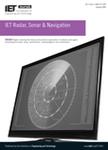版权所有:内蒙古大学图书馆 技术提供:维普资讯• 智图
内蒙古自治区呼和浩特市赛罕区大学西街235号 邮编: 010021

作者机构:Harbin Inst Technol Sch Elect & Informat Engn Harbin 150000 Heilongjiang Peoples R China Harbin Inst Technol Collaborat Innovat Ctr Informat Sensing & Underst Harbin 150000 Heilongjiang Peoples R China
出 版 物:《IET RADAR SONAR AND NAVIGATION》 (IET雷达、声纳与导航)
年 卷 期:2019年第13卷第1期
页 面:89-97页
核心收录:
学科分类:0810[工学-信息与通信工程] 0808[工学-电气工程] 08[工学]
基 金:National Nature Science Foundation of China Fundamental Research Funds for the Central Universities
主 题:signal classification direction-of-arrival estimation polynomials array signal processing MIMO radar spurious DOAs novel DOA manifold separation technique multicarrier frequencies array manifold vector carrier frequency root-MUSIC polynomials polynomial rooting root-mean-squared error combined root-MUSIC algorithms multicarrier MIMO radar sparse uniform linear arrays direction-of-arrival estimation accuracy multiple-input multiple-output radar DOA estimation ambiguity problem search-free DOA estimation algorithms root-multiple signal classification
摘 要:In this study, sparse uniform linear arrays are used to improve the direction-of-arrival (DOA) estimation accuracy for the multiple-input multiple-output radar. With a suitable choice of multi-carrier frequencies, the DOA estimation ambiguity problem caused by spatial under-sampling can be resolved. Two kinds of search-free DOA estimation algorithms based on root-multiple signal classification (MUSIC) are proposed. The first algorithm directly applies the root-MUSIC to each carrier frequency separately for the true DOAs as well as their spurious DOAs, then, a novel DOA replicas matching algorithm is proposed to obtain the true DOAs from the ambiguous ones. The second algorithm utilises the manifold separation technique (MST) to align the noise subspaces of all multi-carrier frequencies. Using the MST, the separable representation of the array manifold vector of each carrier frequency is obtained, then the root-MUSIC polynomials of all multi-carrier frequencies are combined to construct a new polynomial, the true DOAs can be obtained directly by applying polynomial rooting without any matching processing. The two proposed algorithms are both practical, computationally efficient and robust. Numerical simulations verify the effectiveness of the proposed algorithms in terms of root-mean-squared error.